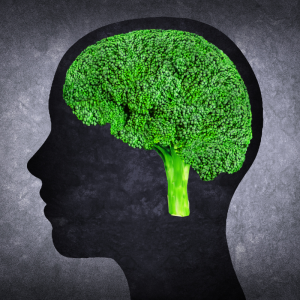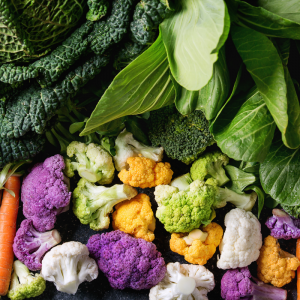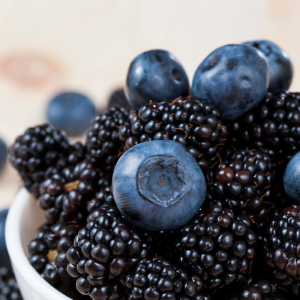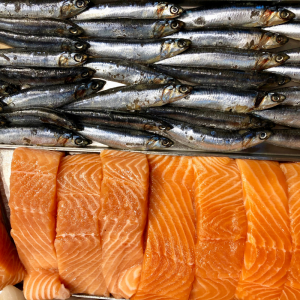 As 2020 comes to a close, I have been thinking a lot about my brain. Partly because who among us hasn’t felt like we were losing our minds at some point during this pandemic year? And partly because it feels like my brain has been misbehaving of late. I recently read that up to 80 percent of women going through menopause (this includes me) have the potential to develop neurological symptoms (and an increased risk of dementia). Food for thought. And enough to send me to my library to refresh my memory on how best to feed your brain.
As 2020 comes to a close, I have been thinking a lot about my brain. Partly because who among us hasn’t felt like we were losing our minds at some point during this pandemic year? And partly because it feels like my brain has been misbehaving of late. I recently read that up to 80 percent of women going through menopause (this includes me) have the potential to develop neurological symptoms (and an increased risk of dementia). Food for thought. And enough to send me to my library to refresh my memory on how best to feed your brain.
I had a bit of a Mosconi marathon reading Brain Food: The Surprising Science of Eating for Cognitive Power and The XX Brain: The Groundbreaking Science Empowering Women to Maximize Cognitive Health and Prevent Alzheimer’s Disease, both by Lisa Mosconi, PhD, Director of the Women’s Brain Initiative and Associate Director of the Alzheimer’s Prevention Clinic at Weill Cornell Medical College (and more). Her impressive CV and the fact she managed to write not one but two books on the topic since March 2018 made me confident she knew a bit about maximizing brain power. Anything noted in quotations in this post is taken from her books unless otherwise noted.
Brain Fog
Dr. Mosconi is infinitely superior at stringing a sentence together than I seem to be at present. Comedian Sandra Shamas has a classic bit regarding loss of nouns as a symptom of perimenopause. Well, now that I am in menopause I seem to be losing my verbs, adverbs and adjectives as well. So I was glad to realize that brain fog, difficulty concentrating and forgetfulness were as typical of menopause as low mood, hot flashes and night sweats. It all comes back to hormones, which is why these neurological issues are also common during motherhood (when we call them baby brain or momnesia). So how can we best weather this hormonal storm?
Well, the good news is that much can be achieved through proper nutrition and lifestyle modifications. This post will focus primarily on nutrition as the lifestyle modifications could easily fill an entire post on their own. There is one thing I will note about lifestyle though. “Lack of physical activity is currently listed as one of the top risk factors for Alzheimer’s, ranked even higher than conditions such as diabetes, obesity, or hypertension”. Serious food for thought.
Alzheimer’s starts with negative changes to the brain in our forties and fifties, not in old age. And, as Dr. Mosconi says “menopause can be the turning point at which medical risks can become actual medical issues [and] also the time when our brains are particularly vulnerable to lifestyle and environmental stressors.” So there is no time like now to refocus on the care and feeding of your brain.
Brain food
We tend to think of what we eat largely in terms of what it does to the shape of our bodies. Instead, we should be thinking of how what we put in our mouths is responsible for creating our state of health, particularly our brain health. Of all the organs in the body, “the brain is the one most vulnerable to the ravages of a poor diet”. The brain is our hungriest organ, “demanding over 20% of your body’s total energy haul”. More importantly, most of our brain cells are with us all our lives, unlike the rest of our cells which can continually renew and replace themselves. “This is something to consider the next time you reach for a candy bar instead of an apple. Whichever one you choose will become part and parcel of how your brain will function.”
One thing I would like to emphasize here. All macronutrients (fat, carbohydrate and protein) are important to brain health. So be wary of any trendy diets suggesting you eliminate or severely restrict any one of these. Not only is it unsustainable in the long run, it could be damaging to your health. I encourage you to think, rather, about the quality of these macronutrients.
Not all fats are created equal just as not all carbs and proteins are created equal. It is the type and source that matters. A slice of Wonderbread and a stalk of broccoli are both carbohydrates, for example, but have vastly different metabolic implications. Wonderbread is a highly processed carbohydrate food that will spike insulin and lead to blood sugar dysregulation and inflammation. While broccoli is a whole food carbohydrate which is low in calories and high in nutrients and fibre. It is also full of health-promoting anti-inflammatory and antioxidant compounds. Need I say more?
And so, without further ado, here are Dr. Mosconi’s “8 steps to a well nourished brain”, which favours the Mediterranean dietary approach.
Dr. Mosconi’s 8 steps to a well nourished brain…
Step 1 – Manage Your Carbs
 Carbs get a bad rap as everyone tends to think that carbs are only starchy foods like bread, pasta and potatoes. But fruits and veggies are all carbs as well. Focus on “all stars” like cruciferous vegetables (e.g. broccoli, cauliflower, kale, arugula), Swiss chard and spinach. These should make up half your plate at every meal. And have two to three servings of high fibre fruits like berries, pears or apples per day. Choose a colourful variety.
Carbs get a bad rap as everyone tends to think that carbs are only starchy foods like bread, pasta and potatoes. But fruits and veggies are all carbs as well. Focus on “all stars” like cruciferous vegetables (e.g. broccoli, cauliflower, kale, arugula), Swiss chard and spinach. These should make up half your plate at every meal. And have two to three servings of high fibre fruits like berries, pears or apples per day. Choose a colourful variety.
And be “complex” in your carb choices. Focus on whole, not refined, grains (think steel cut oats, brown rice, quinoa etc.). Choose legumes like beans and lentils. Think sweet potatoes rather than white potatoes. Complex carbs are high in fibre and fibre should be your new best friend. Fibre is crucial to overall hormonal balance and symptoms of menopause, including neurological symptoms, are a result of hormones (including insulin and estrogen) being out of whack. Aim for 25 grams per day, minimum. Higher is best. You may wish to increase your fiber gradually. Otherwise you may experience some of the less attractive side effects (such as gas or, ironically, constipation) which may occur until your body gets used to the new regime. Always remember to drink enough water (see Step 6).
Limit your use of sweeteners. Where you (sparingly) use them, choose natural sugars like maple syrup or honey rather than refined sugars or sugar substitutes.
Step 2 – Meet Ms. Phytoestrogen
Estrogen is far more than just a sex hormone. Estrogen, specifically 17-beta estradiol, is a major hormonal driver of women’s brain health. It is key to regulating energy production, protects our nerve cells, encourages the formation of new connections between cells, improves blood (and therefore nutrient) flow, influences the production of GABA (aka “nature’s Prozac”) and promotes the release of endorphins (the body’s natural painkillers).
Wow. No wonder the drop in estrogen associated with menopause can wreak such havoc on our brains. And it explains why phytoestrogens, which are plant estrogens, can help. They translate to usable estrogen in our own bodies, but with milder effects. There are two major types: isoflavones (think soy) and lignans (think seeds, whole grains and legumes as well as several fruits and vegetables). As with anything, quality is paramount. The only soy worth eating is organic and minimally processed and fermented (like tempeh, miso and natto) is best. Flaxseeds, sesame seeds (think tahini) and chickpeas are examples of foods particularly high in lignans.
Step 3 – Protect Your Brain with Antioxidants
Of all our organs, our brain suffers the most from oxidative stress, i.e., the inability to fully counteract harmful free radicals. So the more antioxidants in your diet, the greater your ability to reduce oxidative stress and the healthier your brain (and the rest of you) will be. The most powerful antioxidants are vitamins C and E, beta-carotene (the precursor to vitamin A), selenium and a plethora of plant-based compounds that are responsible for their bright colours. So, this is another reason to “eat the rainbow” and consume as many colourful veggies and fruits in as you can on a daily basis.
 Fruits like blueberries and blackberries pack a particularly strong antioxidant punch. Cruciferous veggies are antioxidant powerhouses as well. Artichokes rule, with more antioxidant density than any other fruit or vegetable (just one of the reasons I am such an artichoke fan). And, of course, you want to limit foods that cause oxidative stress in the first place, things like highly processed foods, fried foods, and sugar-sweetened beverages.
Fruits like blueberries and blackberries pack a particularly strong antioxidant punch. Cruciferous veggies are antioxidant powerhouses as well. Artichokes rule, with more antioxidant density than any other fruit or vegetable (just one of the reasons I am such an artichoke fan). And, of course, you want to limit foods that cause oxidative stress in the first place, things like highly processed foods, fried foods, and sugar-sweetened beverages.
Step 4 – Choose the Right Fats
Once again, not all fats are created equal. Fats that come from whole foods are healthier than fats generally found in processed foods, especially as most processed food manufacturers choose the cheapest fats so as to maximize profits. How often do you see extra virgin olive oil in the prepared salad dressings on supermarket shelves, for example? Virtually never. So I encourage you to always make your own salad dressings with high quality olive oil. It takes less than a minute. I like a vinegar kick in my salads so I just mix equal parts olive oil and red wine vinegar with a pinch of salt and pepper in a mason jar and shake it up to blend it. If I want to get fancier about it, I add a little Dijon mustard. Even fancier, but not necessary, add some garlic or herbs. Super simple!
So avoid at all costs processed fats and those highly refined, deodorized vegetable oils you find in clear plastic bottles. But fats you consume by eating nuts and seeds, or olives, or oily fish are unquestionably good for the brain. After all, about two-thirds of our brain is fat, 20 percent of which is docosahexanoic acid (DHA), an omega-3 fatty acid. DHA participates in the formation of myelin, the white matter that insulates our brain circuits and helps maintain the integrity of the blood-brain barrier, which keeps the brain safe. And it is vital to the part of the brain responsible for higher-order thinking.
It goes without saying that you want a lot of omega-3 in your diet. So it is important to note that no plant foods contain DHA. The closest you get is alpha-linolenic acid (ALA), which is a precursor to DHA. This is the type of omega-3 you find in foods like flax and chia seeds and walnuts. But while we can convert ALA to DHA, we are not terribly efficient at it, with most studies finding a rate of conversion of a measly 10%. So if you are a vegetarian or a vegan, it is important to take a supplement.
 For the rest of us, the so-called SMASH fish are your best sources: salmon, mackerel, anchovies, sardines and herring. Several studies have “concluded that regular fish consumption is crucial for brain health” and “middle-age and older people who consumed fish once or twice a week reduced their risk of Alzheimer’s by up to 70 percent”. Just beware of fish high in mercury, a neurotoxin (e.g. swordfish, shark and several types of tuna). And deep fried fish and chips are, of course, not recommended.
For the rest of us, the so-called SMASH fish are your best sources: salmon, mackerel, anchovies, sardines and herring. Several studies have “concluded that regular fish consumption is crucial for brain health” and “middle-age and older people who consumed fish once or twice a week reduced their risk of Alzheimer’s by up to 70 percent”. Just beware of fish high in mercury, a neurotoxin (e.g. swordfish, shark and several types of tuna). And deep fried fish and chips are, of course, not recommended.
In addition to the polyunsaturated omega-3 fats, a higher intake of monounsaturated fatty acids (MUFAs) is also associated with better cognitive performance in women. Nuts such as almonds, cashews and hazelnuts (and their nut butters) as well as avocados and olives are good sources of MUFAs.
As for saturated fats, the controversy continues. After being vilified for decades it appears that perhaps these fats aren’t quite as damaging as once thought. Like all foods, however, it depends on the source and quality. As much as possible avoid processed meats and organic meat and dairy is preferred. Grass-fed is even better as it generally has a higher concentration of omega-3 fatty acids. As for dairy, feel free to go full-fat! Manufacturers tend to add refined sugar, starches and additives to skim milk and skim milk products to improve flavour and texture. Better to enjoy the full-fat version in moderation.
Finally, don’t fear foods containing cholesterol. They have a much smaller effect on blood cholesterol than does saturated fat. For years we avoided eggs due to the cholesterol in the yolks. But eggs are loaded with nutrients that support the brain. After all, they are the ‘seeds’ of a new organism, the development of which begins with the neural tube (aka the brain). And they are rich in choline, a nutrient that supports memory formation.
Step 5 – Feed Your Microbes
You have likely heard of the gut-brain connection. The trillions of microbes in our guts impact our digestion, metabolism, immune system and they even produce some essential vitamins. “New research reveals that our microbiome is also involved in several aspects of our brain health and behaviour, especially in our reactions to stress and anxiety, while at the same time supporting brain longevity.”
To support the care of feeding of these microbes, see Step 1, particularly the bit about making fibre your new best friend. The other way is to eat a highly varied diet as this leads to a diverse set of organisms. As always, avoid processed foods. When your diet is low in fiber and high in processed meats and other processed foods, the balance tips in favour of more harmful gut bacteria, leading to gastrointestinal issues but also low mood, anxiety, depression and even forgetfulness.
And both prebiotic and probiotic foods are important to include in your diet. Think of prebiotics as fertilizer for your good gut bacteria. Excellent sources include garlic, onions, asparagus, cabbage, leeks, artichokes, beans, lentils and bananas. Probiotics are live bacteria with beneficial gut effects. These are in fermented foods like yogurt (organic and full fat is best – avoid sweetened yogurts like the plague), kefir, miso, kombucha, sauerkraut, kimchi and brine-fermented pickles.
Step 6 – Alcohol and Coffee…Make Way for Spring Water
I don’t know about you, but I can’t process alcohol like I used to. It seems that this is not unusual as the liver begins to slow down after the age of forty, slowing your metabolism overall (another factor contributing to weight gain). Alcohol taxes your liver, adds empty calories, disturbs your sleep and raises levels of cortisol, your stress hormone. And if you drink more than a moderate level of alcohol, it can have damaging effects the brain. Some effects, like slurred speech and diminished memory are immediate and obvious. Others, like long-term cellular damage, are not so obvious. I just don’t feel my best if I have more than a single glass of wine of an evening now. It just isn’t worth it.
Coffee is high in antioxidants, so it is better for your brain than alcohol for sure! But again, consider how much you drink and what you put in it. If you add tonnes of sugar or that cocktail of chemicals known as coffee creamer, you will negate much of the healthy effect. Just avoid overdoing it on caffeine or having it past noon as that will diminish sleep quality, which is paramount for brain health (read more about sleep and your mind in this post).
I find coffee makes me jittery so I am a fan of green tea, in particular matcha tea (as you may recall from my recent post highlighting Mega Matcha). This has even more antioxidants than black tea. And the combination of caffeine and L-theanine present in green tea work to improve cognitive function and clarity, making matcha ideal for boosting brainpower.
 But the beverage we need the most is water. Our brains are 80% water and the brain needs water to make hormones and neurotransmitters. Water also increases blood flow to the brain so even mild dehydration can impair cognitive function. And water helps act as a shock absorber for our brains. Even four to six hours without water may bring on brain fog, fatigue, dizziness, confusion, headache and even brain shrinkage.
But the beverage we need the most is water. Our brains are 80% water and the brain needs water to make hormones and neurotransmitters. Water also increases blood flow to the brain so even mild dehydration can impair cognitive function. And water helps act as a shock absorber for our brains. Even four to six hours without water may bring on brain fog, fatigue, dizziness, confusion, headache and even brain shrinkage.
So sip water regularly throughout the day. Spring water (sparkling or still) is excellent as it contains natural minerals and electrolytes. One of Dr. Mosconi’s favourite brain-healthy tips is this: “Drink a glass of plain warm water first thing in the morning. Warm water is more hydrating than cold water because it has a vasodilating effect, which means it makes your veins pop, promoting absorption….it wakes you up and kick-starts your digestion”.
Step 7 – Go Organic as Much as You Can
According to Dr. Mosconi, “as many as 25% of the pesticides routinely sprayed on non-organic fruits and vegetables are known to disrupt the estrogen balance in the body”. Given how important estrogen is for the brain, you can see how consuming these might impair brain health. Organically grown food tends to be more expensive but you can mitigate this by choosing wisely. If purchasing fruits or vegetables with thick peels that will be discarded, then it isn’t necessary to buy organic. Organically raised meat is important as when animal feed contains such contaminants, these same chemicals are stored in their fat and muscle, which you then eat. Similarly, choose wild caught fish over farmed fish whenever possible. We are what we eat. And so we what what we eat eats is important too.
Step 8 – Eat Less
There is “nearly a century of scientific data showing that stressing our bodies and brains via calorie restriction pushes our cells to grow stronger and more resilient”. This is akin to how weight training stresses our muscles, forcing them to repair and come back stronger. Calorie restriction also “boosts the brain’s antioxidant defense system”. Eating less is also helpful for keeping us at a healthier weight. You can read about the many benefits of fasting, as well as some tips on how to go about it here.
I am not talking about anything drastic. I recommend you experiment to find what works for you. For myself, I find a combination works best. One method is based on the Japanese concept of hara hachi bu, or eating until you are 80 percent full. The second is consuming my food as two meals within 9 hours. This gives me a 15 hour overnight “fast”. Whenever I eat until I am full or if I eat too often, I feel sluggish in both body and mind. I like to exercise in the morning on an empty stomach and I am not a fan of rising before dawn, so it is easy for me not to start eating until brunchtime.
Of course, you must focus on steps 1-7 also, so the calories you are consuming are from nutrient-dense, brain-healthy foods. Fruits and veggies are very low in calories yet full in fibre, which adds to satiety. So eat lots of veggies and low glycemic fruits. Add in lean protein and healthy fats while avoiding sugary and processed foods and you have a recipe for sustained energy and better brain health.
One Step at a Time
Yes, many of these steps are common sense. Yet we often don’t listen to what our brains tell us is good for us. So my advice is to start with one of the eight steps (the one most appealing to you) and work with it until it has become your natural and preferred way of eating. Then move on to the next. I find that trying new habits is a bit like throwing the proverbial spaghetti (whole grain of course) against the wall: keep trying and eventually something will stick.
A word about Kirtan Kriya
I know I said I was going to focus on nutrition but I do want to mention one lifestyle practice that I newly discovered through Dr. Mosconi’s book. Especially as one way to keep your brain healthy is to learn something new. This is Kirtan Kriya, which is a singing meditation from the Kundalini yoga tradition. According to the Alzheimer’s Research & Prevention Foundation, “practicing it for just 12 minutes a day has been shown to reduce stress levels and increase activity in areas of the brain that are central to memory.” Though if you sing like I do, it just might make those you live with lose their minds. 😉
Thanks Laurie,
Great article, I really enjoyed it and will try some of your suggestions.
Liz
I’m glad you enjoyed the post, Liz, and thanks for telling me so. Would love to hear which suggestion(s) work best for you.